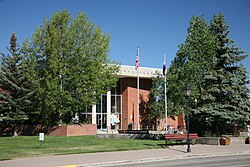2020 census
As of the 2020 census, the county had a population of 7,436. Of the residents, 20.9% were under the age of 18 and 12.5% were 65 years of age or older; the median age was 36.0 years. For every 100 females there were 116.4 males, and for every 100 females age 18 and over there were 121.2 males. 61.0% of residents lived in urban areas and 39.0% lived in rural areas. [10] [11] [12]
The racial makeup of the county was 67.2% White, 0.5% Black or African American, 2.1% American Indian and Alaska Native, 0.9% Asian, 0.1% Native Hawaiian and Pacific Islander, 14.2% from some other race, and 15.0% from two or more races. Hispanic or Latino residents of any race comprised 35.8% of the population. [12]
There were 3,075 households in the county, of which 27.1% had children under the age of 18 living with them and 19.1% had a female householder with no spouse or partner present. About 30.0% of all households were made up of individuals and 9.3% had someone living alone who was 65 years of age or older. [11]
There were 4,303 housing units, of which 28.5% were vacant. Among occupied housing units, 65.6% were owner-occupied and 34.4% were renter-occupied. The homeowner vacancy rate was 1.3% and the rental vacancy rate was 7.6%. [11]
2000 census
As of the 2000 census, there were 7,812 people, 2,977 households, and 1,914 families living in the county. The population density was 21 people per square mile (8.1 people/km2). There were 3,913 housing units at an average density of 10 units per square mile (3.9 units/km2). The racial makeup of the county was 77.60% White, 0.18% Black or African American, 1.25% Native American, 0.31% Asian, 0.05% Pacific Islander, 17.99% from other races, and 2.62% from two or more races. 36.14% of the population were Hispanic or Latino of any race.
There were 2,977 households, out of which 33.90% had children under the age of 18 living with them, 50.70% were married couples living together, 8.40% had a female householder with no husband present, and 35.70% were non-families. 26.30% of all households were made up of individuals, and 5.60% had someone living alone who was 65 years of age or older. The average household size was 2.59 and the average family size was 3.15.
In the county, the population was spread out, with 26.90% under the age of 18, 12.80% from 18 to 24, 33.10% from 25 to 44, 20.60% from 45 to 64, and 6.60% who were 65 years of age or older. The median age was 30 years. For every 100 females there were 115.80 males. For every 100 females age 18 and over, there were 116.70 males.
The median income for a household in the county was $37,691, and the median income for a family was $41,652. Males had a median income of $30,977 versus $24,415 for females. The per capita income for the county was $18,524. About 9.50% of families and 12.90% of the population were below the poverty line, including 15.60% of those under age 18 and 6.30% of those age 65 or over.





